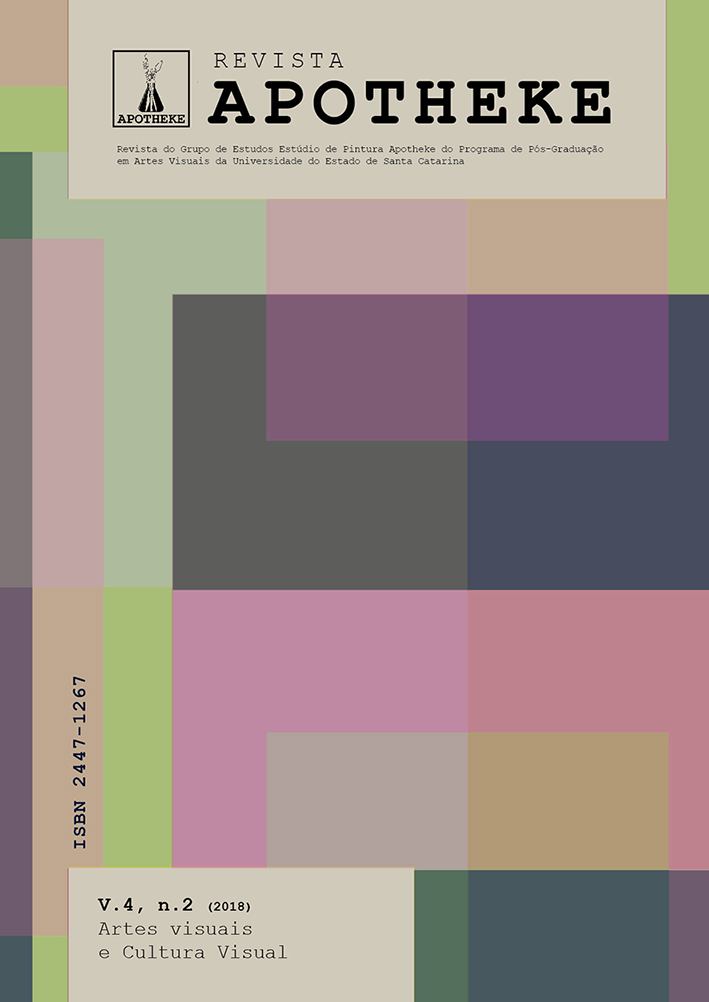Na terra do nunca: cultura visual, arte e maternidade
DOI:
https://doi.org/10.5965/24471267422018008Keywords:
cultura visual , práticas artisticas contemporâneas , maternidade , visualidadeAbstract
Neste texto traço as contribuições que a arte contemporânea faz para a cultura da imagem associada às mães, isto é, o quanto as práticas artísticas da contemporaneidade colaboram com a desmistificação da maternidade que a mídia coloca como algo pleno, belo e natural, quando sabemos que a verdadeira face da maternidade difere muito dessa imagem. É construída uma interlocução entre relato de experiências, práticas artísticas e referenciais teóricos feministas e da cultura visual. É parte da investigação e intercâmbio entre mães artistas que interferem, participam e produzem conhecimentos para seus agentes e também outras discussões para o campo da arte e visualidades.
Downloads
References
BADINTER, ELISABETH. Um amor conquistado: o mito do amor materno. Tradução de Waltensir Dutra. — Rio de Janeiro: Nova Fronteira, 1985.
BUTLER, JUDITH. Cuerpos que importan. Sobre los límites materiales y discursivos del sexo. En Taylor Diana &. Estudios Avanzados, 2002
CASTRO M. AMANDA e MACHADO F. CÁSSIA. Estudos feministas, mulheres e educação popular. (Org.) Curitiba: CVR, 2016.
HERNÁNDEZ, Fernando; Vidiella, Judith; Herraiz, Fernando; Sancho, Maria. El papel de la violência em el aprendizaje de las masculinidades. Revista de Educación, 342. Enero-abril 2007, pp. 103-125.
SOLNÍT, REBECCA. A história do caminhar. Tradução Maria do Carmo Zanini. – São Paulo: Martins Fontes – selo Martins, 2016.
TRAFÍ, Laura. Perturbar la historia del arte desde el lugar de la espectadora Las aportaciones de Pollock y Bal a lós estudios visuales. Visualidades. Revista do Programa de mestrado em cultura visual – Fav UFG 2003.
Sites:
CASHDAN, MARINA. You Can Be a Mother and Still Be a Successful Artist. Disponivel em https://www.artsy.net/article/artsy- editorial-why-motherhood-won-t-hinder-your-career-as-an-artist> Acesso em 15 de agosto de 2017.
FINCO, NINA. Por que em museu só entra mulher nua?.Disponível em <http://epoca.globo.com/cultura/noticia/2017/09/por-que-em-museu-so- entra-mulher-nua.html> Acesso em 29 de setembro de 2017.
MACÊDO, SILVANA BARBOSA. A expressão do poder materno na arte contemporânea. Disponível em
<https://lookaside.fbsbx.com/file/SILVANA_MACEDOArtigoIlustrado.pdf token=AWyzIyZQmi5MBxrgrZC4IqoCXM_wja1FxSpeO2ilR_Au43elhTk_AYCja5H3Ep B321w_7yo8ZtKtnWX9HE_oViDC5ntwJLezyc7s1gRrB5rnVT4vCy5JFQSvH2w2SDUSDF UtpfNcqJAvtDCTpiy96dMX> Acesso em
de setembro de 2017.
PETRINÌ, ILZE e SEPÚLVEDA T. JORGE. Ninguno de nosostros es tan inteligente como todos nosostros juntos. Disponível em
Downloads
Published
How to Cite
Issue
Section
License
Copyright (c) 2018 REVISTA APOTHEKE

This work is licensed under a Creative Commons Attribution-NonCommercial 4.0 International License.
Copyright and Licensing Policy
Authors of works submitted to Revista APOTHEKE authorize their publication in both print and digital formats exclusively for academic purposes. Reproduction is permitted, provided that the source is properly cited. Authors confirm the originality, authorship, and unpublished status of their manuscripts.
Articles published by the journal are freely available and intended for academic and non-commercial use only. All copyrights are transferred to the journal. The content of signed articles reflects the views of their respective authors and not the official position of Revista Apotheke. The author(s) agree to always cite the following reference when republishing or referring to the content originally published in Revista Apotheke:
“This article was originally published by Revista Apotheke in volume (insert volume), number (insert number), year (insert year), and is available at: http://www.revistas.udesc.br/index.php/APOTHEKE/index”
It is the sole responsibility of the authors to obtain written permission for the use of any material protected by copyright law included in their articles. Revista Apotheke is not responsible for copyright infringements committed by contributors.
Authors retain copyright and grant the journal the right of first publication, with the work licensed under a Creative Commons Attribution-NonCommercial License (CC BY-NC):
-
Attribution (BY): Licensees are allowed to copy, distribute, display, perform, and create derivative works, provided that proper credit is given to the author or licensor, in the manner specified.
-
NonCommercial (NC): Licensees may use the material only for non-commercial purposes.
After publication, authors retain the rights to their work and may republish the text.



